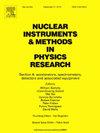Investigating the impact of metalloporphyrins on DNA damage during electron beam irradiation
IF 1.5
3区 物理与天体物理
Q3 INSTRUMENTS & INSTRUMENTATION
Nuclear Instruments & Methods in Physics Research Section A-accelerators Spectrometers Detectors and Associated Equipment
Pub Date : 2025-02-14
DOI:10.1016/j.nima.2025.170328
引用次数: 0
Abstract
This study explores the dose-dependent effects of ultrashort electron beams on DNA damage and the role of Zn-containing porphyrins in modulating this interaction. As advancements in electron beam technology continue to emerge, their potential applications in fields such as medicine and genetic engineering are becoming increasingly significant. However, the complex mechanisms governing the interaction between ultrashort electron beams and DNA remain largely uncharted. We investigated the influence of varying electron beam doses on DNA isolated from the calf thymus, as well as on DNA/porphyrin complexes. The presence of ZnTOEPyP porphyrin and its effects on radiation-induced DNA damage were examined at different relative concentrations of the complexes (r = 0.01; 0.02; 0.04, where r = Cporph./CDNA) and compared to previous findings. The study sought to uncover the potential potentiating effects of porphyrins on DNA damage, dependent on both porphyrin concentration and radiation dose. Utilizing spectroscopic melting methods in a 10−3 M NaCl buffer solution. We identified the dependence of porphyrin-induced protective or radiation-enhancing effects on the combination of relative concentration and irradiation dose.
求助全文
约1分钟内获得全文
求助全文
来源期刊
CiteScore
3.20
自引率
21.40%
发文量
787
审稿时长
1 months
期刊介绍:
Section A of Nuclear Instruments and Methods in Physics Research publishes papers on design, manufacturing and performance of scientific instruments with an emphasis on large scale facilities. This includes the development of particle accelerators, ion sources, beam transport systems and target arrangements as well as the use of secondary phenomena such as synchrotron radiation and free electron lasers. It also includes all types of instrumentation for the detection and spectrometry of radiations from high energy processes and nuclear decays, as well as instrumentation for experiments at nuclear reactors. Specialized electronics for nuclear and other types of spectrometry as well as computerization of measurements and control systems in this area also find their place in the A section.
Theoretical as well as experimental papers are accepted.

 求助内容:
求助内容: 应助结果提醒方式:
应助结果提醒方式:


